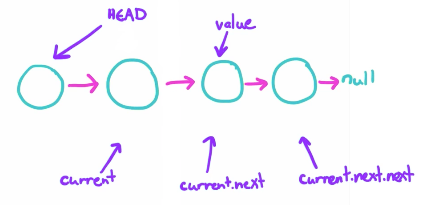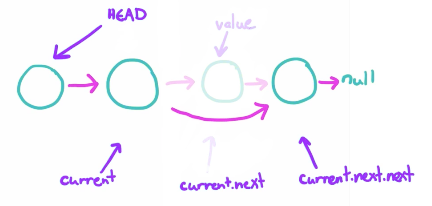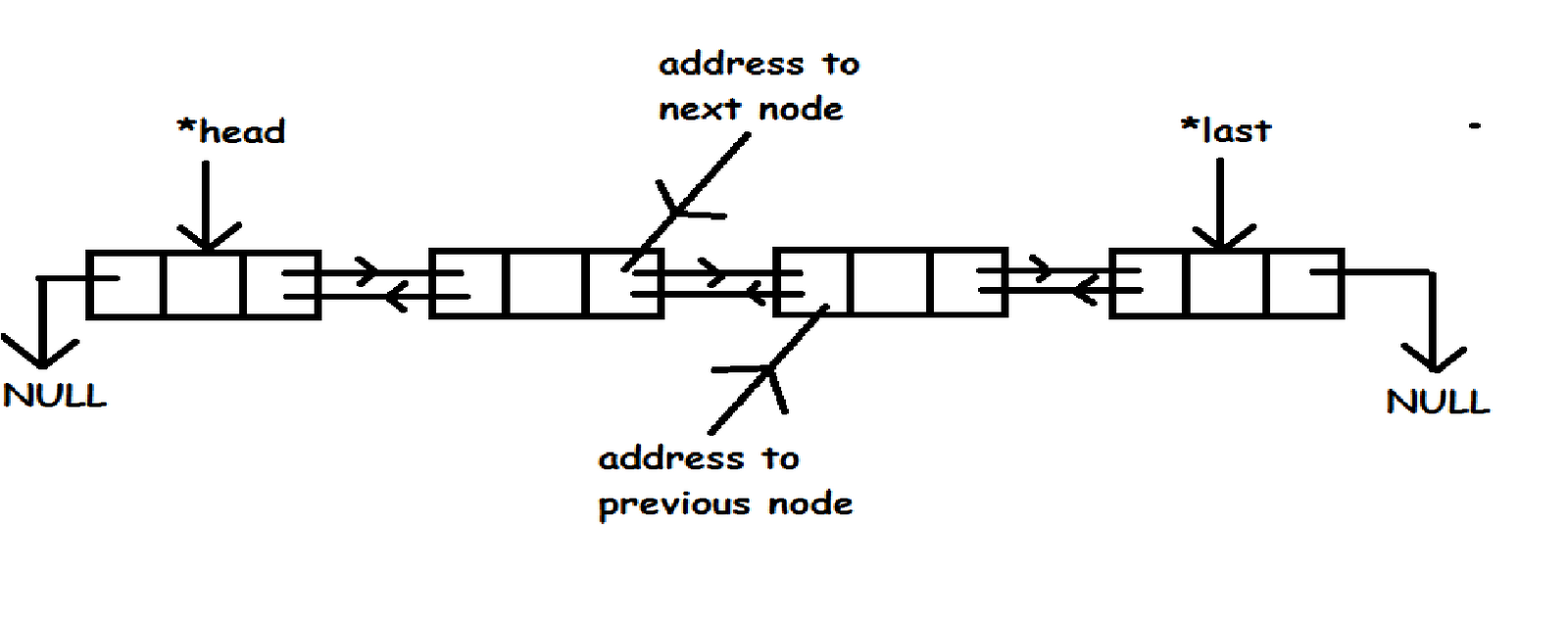
Linked List - Java
개요
- Singly Linked List 장점과 단점
- Java built-in LinkedList class
- Doubly Linked List 에 대한 간단한 설명
- Linked List 를 사용하여 구현할 수 있는 또 다른 데이터 구조
- 구현예제보기
Singly Linked List

얼핏 보면 array 와 비슷하게 생긴 자료구조가 linked list 이다. 박스 같이 생긴 하나하나를 node 라고 부르고, 각 node 는 다음 node 의 참조값을 가지고 있다. 아래는 array 와 비교했을 때 linked list 가 가지는 장단점이다.
Linked List 의 장점
- 동적 size 조절 가능
- 데이터 삽입/삭제가 편함
동적 size 조절의 경우, java 의 ArrayList 와 같은 클래스를 사용하면 할 수 있는 것 처럼 보이지만 ArrayList 는 사실상 copy 방식이므로 (여기참고) 동적 size 조절이 되는 것 처럼 보이게 한 것이지 실제로는 linked list 의 방식에 비해 비용이 많이 드는 방식이다. 반면, linked list 는 head, tail 포인터만 있다면 list 의 앞 뒤 어디든 삽입 연산의 경우 O(1) 의 시간복잡도를 가진다.
Linked List 의 단점
- Random access 불가능. 첫 번째 요소 부터 탐색해야 한다. Binary search 같은 작업은 linked list 만으로는 어렵다.
- 각 노드의 reference 를 저장할 공간이 추가적으로 필요하다.
Singly Linked List 의 구현 - Java
구현 메소드 3가지
- 기존 리스트의 맨 뒤에 node 를 추가하는 append()
- head 앞에 node 를 추가하는 prepend()
- 지정한 값을 가지고 있는 node 를 삭제 하는 deleteWithValue()
class 정의
먼저 LinkedList 라는 이름으로 class 를 하나 만든다. 이 linked list 는 head 라는 Node 타입의 reference 변수를 가지고 있는데 linked list 의 진입점이라고 할 수 있다. 그러면 Node class 에 대한 정의도 필요하겠다. Node 클래스는 LinkedList 객체 내부적으로만 조작할 수 있도록 하기 위해 private 제어자를 둔다. Node 클래스는 다음 값을 가리킬 레퍼런스 변수 next 와 자신의 값 data 를 가진다.
class LinkedList {
Node head;
private class Node {
Node next;
int data;
public Node(int data){
this.data = data;
this.next = null;
}
}
}
append()
- 현재 head 가 null 이면 (아무것도 없으면) head 에 새롭게 append 할 node 를 붙여준다.
- 그렇지 않은 경우 현재 head 를 current 라는 변수로 받고 리스트의 가장 끝으로 간다.
- current 를 마지막 node 로 옮겨간다 - while 문
- current.next == null 이면 current 는 마지막 node 에 도착한 것이다.
- current.next = “추가할 노드” 지정해주면 끝이다.
구현은 아래와 같다.
public void append(int data) {
Node appendNode = new Node(data);
// 현재 head 가 null 이면 (아무것도 없으면) head 에 새롭게 append 할 node 를 붙여준다.
if (head == null) {
head = appendNode;
return;
}
// 그렇지 않은 경우 현재 head 를 current 라는 변수로 받고 리스트의 가장 끝으로 간다.
Node current = head;
while (current.next != null) { // current.next == null 이면 current 는 마지막 node 에 도착한 것이다
current = current.next; // current 를 마지막 node 로 옮겨간다.
}
current.next = appendNode; // current.next = "추가할 노드" 지정해주면 끝이다
}
prepend()
prepend 메소드 구현은 단순하다. 구현은 아래와 같다.
public void prepend(int data) {
Node newHead = new Node(data);
newHead.next = head;
head = newHead;
}
deleteWithValue()
그나마 조금 까다로워 보일 수 있는 특정 값을 지우는 메소드인데 비슷하게 하면 된다.
- head 부터 시작한다
- 리스트가 비어있는 경우 리턴
- 찾는 값이 head 에 있나? 그러면 head 삭제
- head 를 제외한 나머지. 그림 참고.

그림1 지우려는 노드가 value 로 표시된 노드라면, node 하나씩 탐색 중 current.next.data 가 현재 지우려는 값과 일치 할 것이다.

그림2 current.next 는 지우려는 node 를 가리키고 있었을 것이고, 지우려는 node 의 다음 node 는 current.next.next 로 표현할 수 있다. 그러므로 current.next = current.next.next 를 해주면 지우려는 node 이전의 node (current) 가 지우려는 node 다음 node (current.next.next) 와 연결되어 지우려는 노드는 연결에서 disconnect 된다.
public boolean deleteWithValue(int data) {
Node current = head; // head 부터 시작한다
if (head == null) return false; // 리스트가 비어있는 경우 리턴
// 찾는 값이 head 에 있나? 그러면 head 삭제
if (current.data == data) {
head = head.next;
return true;
}
// head 를 제외한 나머지. 그림 참고.
while (current.next != null) {
if (current.next.data == data) {
current.next = current.next.next;
return true;
}
current = current.next;
}
return false;
}
print() 만들어보기
혹시 다른 메소드 만들어 보고 싶은 게 있다면 1->2->3->4 이런식으로 출력되는 print() 메소드 만들어 보는 것도 재밌다. Sample Code
Linked List 의 사용 예
- Stack
- Queue
- Graph
- Tree
등 다양한 곳에 다양한 목적으로 사용될 수 있는 기본적인 data structure 가 linked list 이다.
Java built-in LinkedList class
사실 java 에도 기본적으로 지원되는 LinkedList class 가 있다. AbstractSequentialList 를 상속받고 List 인터페이스를 구현한 클래스이다. 아래와 같은 방법으로 Queue 로 사용할 수 있다.
built-in LinkedList class 를 사용한 Queue
import java.util.LinkedList;
import java.util.Queue;
public class BuiltinLinkedListQueueExample {
public static void main(String[] args){
Queue<Integer> queue = new LinkedList<>();
queue.add(1);
queue.add(2);
queue.add(3);
queue.add(4);
queue.add(5);
queue.add(6);
queue.add(7);
System.out.println(queue.remove());
System.out.println(queue.toString());
}
}
built-in LinkedList class 소스 까보기
Built-in LinkedList 소스를 까보면 linkLast(), linkBefore() 메소드에서 재밌는 것을 발견 할 수 있다. 글 시작부의 타이틀에 Singly Linked List 라는 표현을 썼다. 가장 기초가 되는 linked list 구현이었고, 한 방향으로만 연결되는 linked list 이기 때문이다. 참조값으로도 head 하나 밖에 쓰지 않았다. 하지만 built-in LinkedList 에는 first, last, prev, next 네 가지의 참조변수가 있다.
/**
* Links e as last element.
*/
void linkLast(E e) {
final Node<E> l = last;
final Node<E> newNode = new Node<>(l, e, null);
last = newNode;
if (l == null)
first = newNode;
else
l.next = newNode;
size++;
modCount++;
}
/**
* Inserts element e before non-null Node succ.
*/
void linkBefore(E e, Node<E> succ) {
// assert succ != null;
final Node<E> pred = succ.prev;
final Node<E> newNode = new Node<>(pred, e, succ);
succ.prev = newNode;
if (pred == null)
first = newNode;
else
pred.next = newNode;
size++;
modCount++;
}
이러한 방식을 Doubly Linked List 라고 하고 아래와 같이 각 node 들은 자신의 이전 node 에 대한 레퍼 값도 가지고 있다.
Java doc 의 LinkedList class 페이지로 가보면 아래와 같은 설명을 볼 수 있다.
Doubly-linked list implementation of the List and Deque interfaces.

위 구현 그림을 보면 head(first), last(tail) 포인터도 존재하는데 Queue 를 구현할 때에는 보통 head, tail 두 종류의 포인터를 함께 쓴다. append 는 tail 에 하고, remove 는 head 에서 하여 FIFO 를 구현하기 때문이다. (Stack 의 경우에는 head 하나만 있어도 된다. LIFO 이기 때문에.) Linked List 를 이용한 Stack, Queue 를 직접 구현하는 것은 다음 포스팅에서 다뤄 봐야겠다.